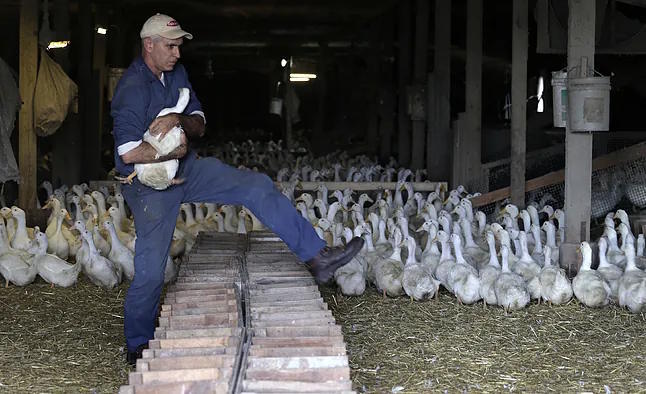In March 2024, an outbreak of avian flu was first detected in dairy cows, specifically on farms in the U.S. It was the first time this pathogen had reached cattle, and its spread in the country was extremely rapid. To date, according to data from the U.S. Department of Agriculture, 1,080 cases in cattle in 18 states have been reported, with the latest cases recorded this past September.
Analyses have revealed that the cause of this unique case worldwide is a highly pathogenic strain of the H5N1 virus, specifically the 2.3.4.4b clade, which has also caused numerous infections in domestic and poultry birds, as well as other mammals besides cows. Since the outbreak began, 70 cases have also been detected in humans, mainly in U.S. farm workers. One of the affected individuals died from the infection.
A study this week uncovers the peculiarities of the pathogen, whose 'behavior' differs from the H5N1 circulating in Europe and Asia. According to details published in the journal Science Advances, the North American strain has two mutations that make it more pathogenic and dangerous.
Through studies in ferrets, the researchers - a team led by Young-Il Kim from the Center for Emerging Virus Studies in South Korea - have identified the genetic markers that help explain the enhanced adaptation and increased virulence displayed by the North American strain. This finding, emphasized in the scientific journal, "highlights the urgent need to strengthen surveillance and specific interventions."
As explained, the identified mutations, present in the PB2-478I and NP-450N genes, enhance the virus's replication capacity and, therefore, its spread in the infected organism, contributing to its virulence. These genetic changes have also contributed to the virus's adaptation to mammals such as cows.
To confirm the involvement of the identified mutations in the virus's ability to spread, the research team conducted an experiment in which they removed the mentioned genetic changes. In those cases, the animals did not experience a systemic infection, as clearly occurred when the mutations were present.
In a second phase of the research, the scientists demonstrated that virus samples with the identified mutations were able to replicate in human cells, as well as in bovine mammary glands. "Our findings underscore the urgent need for active surveillance, preparedness, and interventions aimed at mitigating zoonotic and pandemic threats," the authors stated in a press release.
"This carefully designed study provides crucial scientific evidence on the genetic determinants associated with the virulence of the H5N1 subtype of the avian flu virus. Given the ongoing global spread of this virus and its increasing threat to public health, it is essential to strengthen epidemiological surveillance efforts and continue research focused on the molecular mechanisms of pathogenicity and the virus's adaptation to new mammal species," noted Aitor Nogales González, a virologist at the Animal Health Research Center (CISA, INIA-CSIC), in statements to SMC Spain.
Similarly, this week the Spanish Society of Emergency Medicine (SEMES) has warned about the importance of being prepared for avian flu. Although the strains circulating in Europe and the U.S. are different and exhibiting different 'behaviors,' there is an "increase in outbreaks of Highly Pathogenic Avian Influenza (HPAI) A(H5N1) worldwide," including in Spain.
Since July 2025, outbreaks have been detected in various poultry farms in Extremadura, Castilla-La Mancha, Andalucía, and Castilla y León, as well as in wild birds in different parts of the country, including the Doñana National Park, which is of special importance for the conservation of protected species. As a result, Spain lost its status as a "avian flu-free country" to the World Organization for Animal Health (OIE) in mid-July, the organization recalls.
"Although the risk to the general population in Spain remains very low, and low for individuals with occupational exposure (provided that preventive measures are respected), Emergency services must be aware and prepared to control possible cases," they emphasize.
So far, no cases of human-to-human transmission have occurred. For that to happen, "the virus would have to change significantly, and that has not happened yet," explained Inmaculada Casas, director of the Respiratory Virus and Influenza research group at the Carlos III Health Institute, in a recent briefing organized by SMC Spain.
"Although the risk of transmission to humans exists, this is currently an animal disease with a significant impact," echoed Elisa Pérez Ramírez, a researcher in the Department of Infectious Diseases and Global Health at the Animal Health Research Center CISA-INIA. "When a case of highly pathogenic virus is detected, all animals on the farm must be culled, which means millions of birds have had to be culled worldwide in recent years. It also has an impact on the ecosystem and biodiversity. We should move away from our anthropocentric view and think not about what could happen, but about what is already happening."
